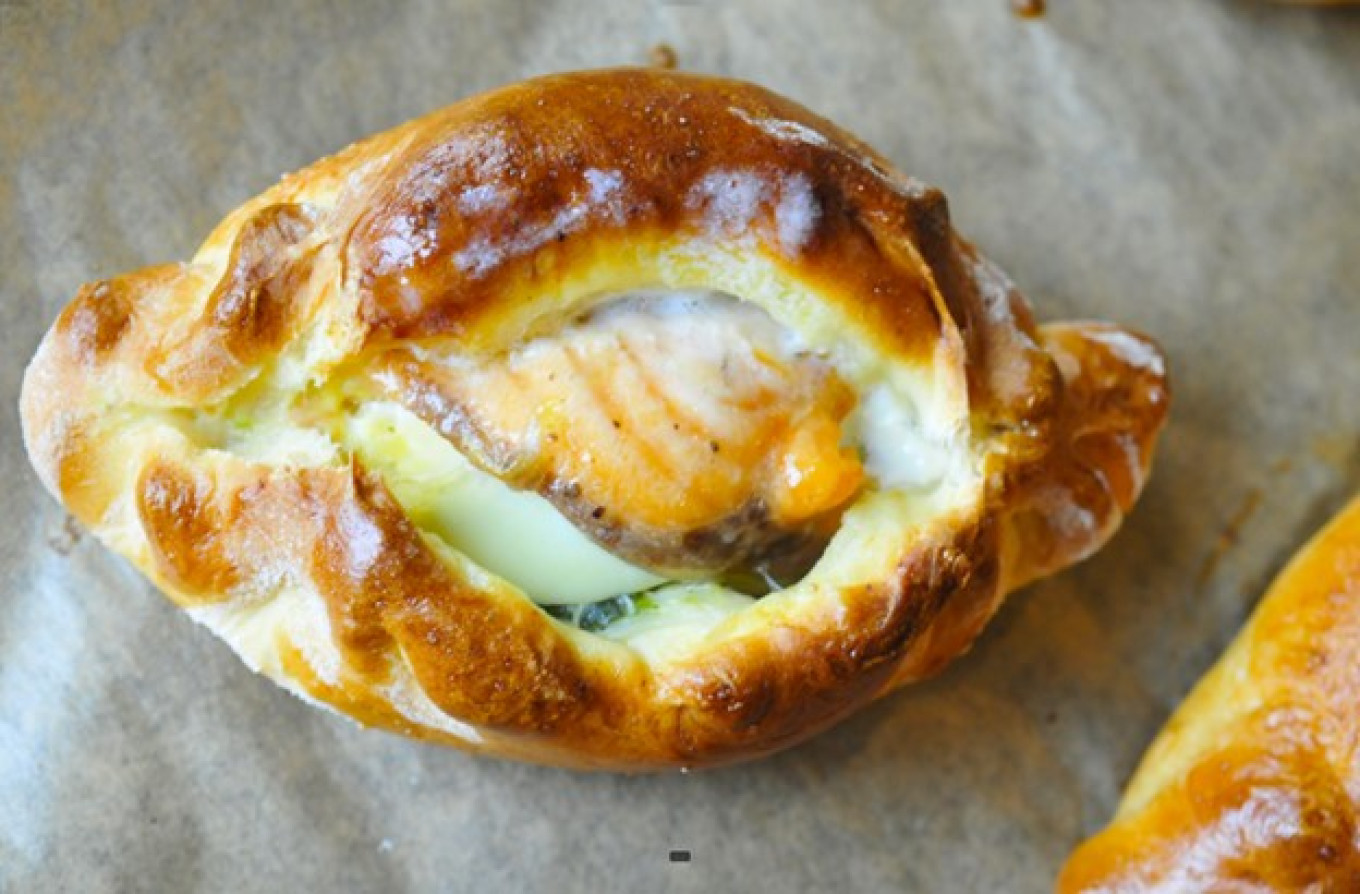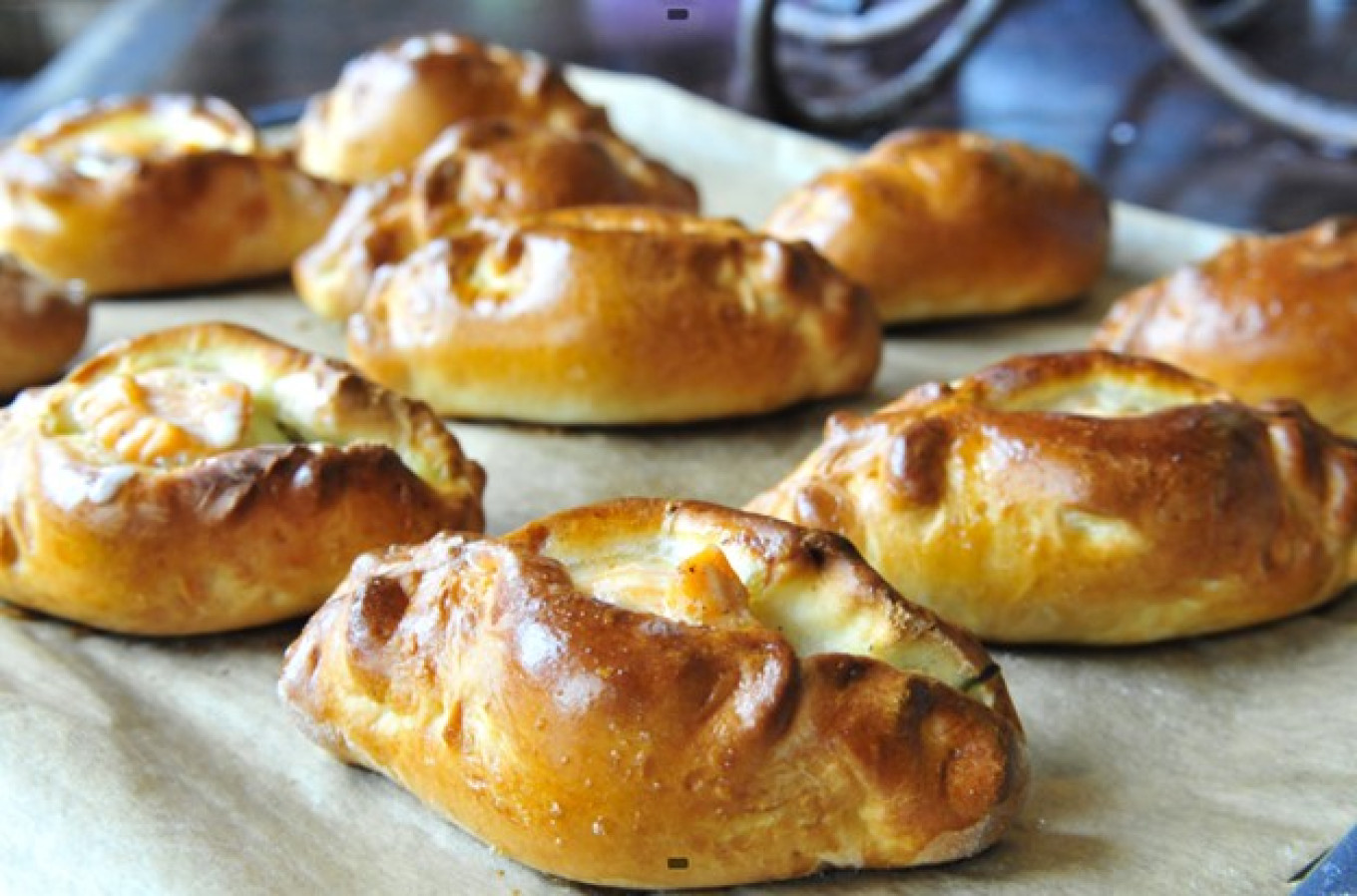The word rasstegai sounds funny in Russian. It sounds like the imperative of the word “unbutton," which is why people joke: Rasstegai is not a command, it’s a pastry.
Actually, the name comes from a word for an old Russian garment. Rasstegai, the lexicographer Vladimir Dal writes, is an “open, unbuttoned, loose shift.” It’s also the word used to describe a slob or a lazy do-nothing, which are, in a way, good descriptions of these filled pastries that are deliberately left unsealed.
The introduction to Russian cuisine for many visitors begins with a bowl of ukha (fish soup) and a plate of rasstegai. Although this seems like the kind of meal Russians ate for centuries, the rasstegai is not as old as you might think.
Even the name is not old. There are no rasstegai pastries in the "Domostroi" (1550s) or other documents in the 17th and 18th centuries. Rasstegai in the sense of filled pastry first appears in the 19th century, in a description of St. Petersburg cuisine of the 1830s by the famous ethnographer Mikhail Pilyaev (1842-1899). But the word was obviously new and required explanation: "During Lent they baked special pastries called rasstegai.” Pilyaev is referring to Ivan (Johann) Isler's cafe-restaurant on Nevsky Prospekt. As you can see, at that time rasstegai were still "special."

Rasstegai appeared in the early 19th century and quickly — in just 10-20 years — became popular and were included in menus at just about every inn or café. What happened? This coincided with another innovation of Russian restaurant life — Roma singers and musicians. This began thanks to Count Alexei Orlov, who brought an entire Roma choir from Moldova.
Ivan Trofimov, the first leader of this choir, made it especially popular in the early 19th century. Roma performed in taverns and wealthy homes. They were warmly welcomed by a well-to-do public - merchants, bankers and the bohemians of the capital. At the time, Roma singing was a magnificent vocal art, unlike the vulgar imitations today.

One of the most celebrated soloists of the Roma choir was Stepanida or Stesha, as she was called on stage. She was the godmother of the new pastry. "Rastegai pastries came into fashion in 1807," writes Mikhail Pyliaev, "when the Moscow singer Stesha worked on the hearts and pockets of her listeners and admirers with her nightingale voice. She was well-known for her brilliant rendition of the romance ‘Unbuttoned Sundress’ [Sarafanchik rasstegaichik]. Chefs began to bake rasstegai in honor of her song.”
Stepanida's art was so popular that she was even called the "Russian Catalani" (Angelica Catalani was the most famous Italian singer of her time with a phenomenal voice). When Stepanida died in 1822, the journal Otechestvennye zapiski published an obituary entitled “Russian Catalani.”

Nowadays rasstegai is a small pastry pie that has an opening down the center. Just before serving, a spoonful or two of broth is poured in the opening. But the filling is a surprise, too. Even the cookbook writer Yelena Molokhovets, who was rather down to earth, has recipes for rasstegai with minced fish and salmon and with fresh herring. Rasstegai were also made with meat and onions. Slices of sturgeon, beluga or salmon were placed on top, even over raw minced meat filling, and then closed — though not completely — with dough.
The kind of rasstegai we are used to is a small pie that you can eat in a couple of bites. But way back when it appeared about 200 years ago, it was a large pastry pie of many servings. No one could eat an entire rasstegai: "When he traveled he usually drank a glass of vodka and ate a pastry or a piece of rasstegai,” Pyotr Boborykin wrote in 1890. Here is a lovely description from a story by Alexander Apraksin (1898): "The peasants sitting with him treated him to vodka with an appetizer of rasstegair, which they all ate from one plate, sipping... from a bowl of broth.”
Moscow rasstegai looked different — they were round. Vladimir Gilyarovsky wrote in his famous collection of stories, "Moscow and Muscovites": "Yegorov's tavern was famous for its blinis and its fish rasstegai. This is a round pie the size of a plate filled with minced fish and vesiga [sturgeon marrow]. It’s open in the center, and a piece of burbot liver is placed on top of a slice of sturgeon. It's served with free bowl of ukha..."
To imagine what rasstegai were like on an elegant restaurant table in the middle of the 19th century, we need only to read this recipe from a book written in 1853 by Ignaty Radetsky, author of the three-volume “Culinary Almanac”:
"Prepare brioche dough, tender quenelles of grouse, fluffy cooked Smolensk grain [buckwheat without the outer shell], and slices of lightly salted salmon. Thirty minutes before they are to be served, place the brioche dough on the table, knead it a little, divide into as many portions as you want pastries. Roll each piece out, brush with egg, place a quenelle of grouse, top with some grain, then a slice of salmon. Close the edges but leave them “unbuttoned,” that is, leave an opening in the center. Put them on a baking tray and place in a warm spot. When they rise a bit, brush with egg and bake in a hot oven. Take the out, brush with butter, pour a bit of red sauce mixed with butter and chopped parsley into the open center and serve hot".
As you can see, there are many different fillings for rasstegai. These pastries are usually served with soups: fish rasstegai for ukha; meat and mushroom rasstegai with bouillon; rice, onion, carrot and egg rasstegai with fish and meat soups.
After the rasstegai is baked and taken out of the oven, bouillon or melted butter is poured into the open center of the pastry.
The old recipe of the last century is difficult to prepare. Here is a modern recipe with detailed instructions. Happy baking!

Rasstegai
For 12 pastries
Ingredients
For the pastry:
- 260 grams (2 cups) flour
- 3 grams (1/2 tsp) salt
- 70 grams (2 tsp) water
- 40 g (2 ½ Tbsp) milk
- 30 g (2 ½ Tbsp) sugar
- 7 g (2 ½ tsp) fresh yeast
- 15 g (1 Tbsp) butter
- 1/2 egg (lightly whisk and halve)
For the filling:
- 200 g (scant half pound) spinach
- 12 quail eggs
- 250 g (generous half pound) fresh salmon or trout
- 150 g (scant 1 cup) pickles or 50 g (scant ½ cup) capers
- juice of 1 lemon
- 1 Tbsp butter to sauté spinach
- 1 Tbsp 22% cream or 1 Tbsp cream cheese
- Salt, pepper to taste
- 1 egg and 1 tbsp water or milk to brush on rasstegai
- butter for the baked rasstegai
Prepare the dough:
- Mix flour with salt. Dissolve yeast in water and sugar in milk and pour into the flour. Add the egg and knead the dough. After 10 minutes of kneading, add butter in small portions. Knead until smooth.
- Place in bowl and cover with a lid or clingfilm. Leave to rise for 2 hours.
- During the first hour, punch down twice at 30-minute intervals.
Meanwhile, prepare the filling:
- Chop the spinach and sauté in butter until tender. Pour in the cream and bring to a boil. The spinach should be moist but without excess liquid.
- Boil the eggs, cool and halve them.
- Cut the pickles into thin slices.
- Cut the fish into thin strips. Squeeze lemon juice over the strips, salt and pepper and leave for 10 minutes.
To assemble and bake:
- Preheat the oven to 180˚C (350˚ F).
- Weigh the dough and divide it into 12 equal parts, form each part into balls, cover with cling film and let them rest for 5-7 minutes.
- Roll out each piece into a flat round and layer the filling: 1 tsp spinach in the middle, then slices of pickle or 2-3 pieces of capers on top, then egg halves on top of that.
- Pull the edges up and pinch the dough closed, leaving the middle open. Roll up a slice of fish and place it in the open middle of the pastry. Place the rasstegai on a baking tray lined with baking paper.
- Allow to proof for 30 minutes. Mix the egg with the milk or water and brush the risen rasstegai with a pastry brush. Bake in a heated oven for 15-20 minutes.
- When they are golden, place a pat of butter in the baked rasstegai or pour in a bit of rich fish broth.

A Message from The Moscow Times:
Dear readers,
We are facing unprecedented challenges. Russia's Prosecutor General's Office has designated The Moscow Times as an "undesirable" organization, criminalizing our work and putting our staff at risk of prosecution. This follows our earlier unjust labeling as a "foreign agent."
These actions are direct attempts to silence independent journalism in Russia. The authorities claim our work "discredits the decisions of the Russian leadership." We see things differently: we strive to provide accurate, unbiased reporting on Russia.
We, the journalists of The Moscow Times, refuse to be silenced. But to continue our work, we need your help.
Your support, no matter how small, makes a world of difference. If you can, please support us monthly starting from just $2. It's quick to set up, and every contribution makes a significant impact.
By supporting The Moscow Times, you're defending open, independent journalism in the face of repression. Thank you for standing with us.
Remind me later.







